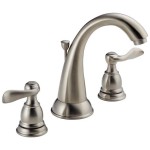Small Sinks For Tiny Bathrooms: Maximizing Space and Style
Limited square footage in a bathroom presents unique design challenges. Every element must be carefully selected to optimize functionality without sacrificing aesthetics. One of the most critical considerations for small bathrooms is the sink, as it is a frequently used fixture that can take up significant space. Small sinks designed specifically for compact bathrooms offer a practical solution, providing essential functionality while maximizing the available area.
This article explores the various types of small sinks suitable for tiny bathrooms, discussing their features, benefits, and design considerations. We will delve into the different mounting options, materials, and styles available, providing information to help homeowners and designers make informed decisions about selecting the appropriate small sink for their specific needs.
Types of Small Sinks for Tiny Bathrooms
The market offers a variety of small sink options tailored to fit the constraints of compact bathrooms. Understanding the different types available is crucial for selecting the best fit for a particular space and design aesthetic.
Wall-Mounted Sinks: These sinks are directly attached to the wall, leaving the floor space beneath completely open. This is a significant advantage in small bathrooms, as it creates the illusion of more space and makes cleaning easier. Wall-mounted sinks come in various shapes and sizes, ranging from simple rectangular basins to more contemporary curved designs. They often require professional installation to ensure proper support and plumbing connections. The absence of a vanity cabinet underneath necessitates alternative storage solutions, such as floating shelves or wall-mounted cabinets.
Corner Sinks: Designed to fit snugly into a corner, these sinks are an excellent option for bathrooms with awkward layouts or limited wall space. Corner sinks maximize otherwise unused areas, freeing up valuable space in the center of the room. They are available in different materials and styles, offering versatility in design. Similar to wall-mounted sinks, corner sinks often lack built-in storage, requiring supplementary storage options in the bathroom.
Pedestal Sinks: Pedestal sinks consist of a sink basin supported by a freestanding pedestal. While they offer a classic and elegant look, pedestal sinks typically do not provide any storage space. However, they are available in smaller sizes suitable for compact bathrooms. Opting for a pedestal sink with a narrower base can further minimize its footprint. The exposed plumbing may require additional attention to detail during installation, such as using decorative pipes and fittings.
Vessel Sinks: Vessel sinks, also known as above-counter sinks, sit on top of a countertop or vanity. They can add a touch of modern flair to a small bathroom. While the sink itself may be compact, the overall footprint depends on the size of the countertop or vanity it sits on. In a very small bathroom, a small floating shelf can serve as the base for a vessel sink, minimizing the overall space occupied. Careful consideration should be given to the height of the sink and the countertop to ensure comfortable use.
Undermount Sinks: Undermount sinks are installed beneath the countertop, creating a seamless and clean look. While the sink basin itself may be compact, the countertop area required can vary. In a small bathroom, using an undermount sink with a small, custom-made vanity can be a space-saving solution. This allows for a combination of a functional sink and minimal storage space underneath.
Factors to Consider When Choosing a Small Sink
Beyond the type of sink, several other factors influence the selection process. These factors include the dimensions of the available space, the desired style of the bathroom, and the need for storage.
Dimensions: Accurately measuring the available space is crucial before choosing a small sink. Consider the width, depth, and height restrictions to ensure the sink fits comfortably without obstructing movement within the bathroom. Pay attention to the plumbing connections and ensure they can be easily accommodated with the chosen sink.
Style: The sink should complement the overall style of the bathroom. Whether the design is modern, traditional, or minimalist, the sink should integrate seamlessly with the existing décor. Consider the shape, color, and material of the sink to achieve the desired aesthetic.
Storage Needs: Storage is often a challenge in small bathrooms. Evaluate the storage requirements for toiletries, cleaning supplies, and other essentials. If possible, choose a small sink that offers some form of integrated storage, such as a vanity cabinet or drawer. Alternatively, plan for supplementary storage solutions, such as shelves, baskets, or wall-mounted organizers.
Material: The material of the sink affects its durability, aesthetics, and maintenance requirements. Common materials for small sinks include:
- Porcelain: A classic and durable option that is easy to clean.
- Ceramic: Similar to porcelain, ceramic sinks are resistant to scratches and stains.
- Stainless Steel: A modern and hygienic option that is resistant to rust and corrosion.
- Glass: Adds a touch of elegance and can be easily cleaned.
- Stone: Offers a natural and luxurious look, but may require more maintenance.
Plumbing: Consider the existing plumbing configuration in the bathroom. Ensure that the chosen sink is compatible with the existing water supply and drain lines. If necessary, consult a plumber to make any necessary adjustments or modifications.
Budget: Small sinks are available in a wide range of price points. Determine a budget before starting the selection process to narrow down the options and avoid overspending. Remember to factor in the cost of installation, plumbing modifications, and any necessary accessories, such as faucets and drains.
Design Ideas and Space-Saving Strategies
Even with a small sink, effective design strategies can further enhance the functionality and aesthetics of a tiny bathroom.
Floating Vanities: Installing a floating vanity beneath a small sink creates the illusion of more space and provides valuable storage. Choose a vanity with a shallow depth to maximize the available floor area. Use open shelving or baskets beneath the sink to store towels, toiletries, or cleaning supplies.
Mirrored Cabinets: Replace a standard bathroom mirror with a mirrored cabinet to add hidden storage space. These cabinets are ideal for storing small items such as toothbrushes, toothpaste, and medications, keeping the countertop clutter-free. Choose a cabinet with a slim profile to minimize its visual impact on the room.
Vertical Storage: Utilize vertical space to maximize storage in a small bathroom. Install tall, narrow shelves or cabinets to store towels, toiletries, and other essentials. Consider using over-the-toilet storage units to make use of otherwise wasted space.
Light and Bright Colors: Use light and bright colors on the walls, floors, and fixtures to create a sense of spaciousness. Light colors reflect light, making the room feel larger and more airy. Avoid dark or heavy colors, which can make the room feel cramped and claustrophobic.
Minimalist Design: Embrace a minimalist design aesthetic to reduce clutter and create a sense of calm in a small bathroom. Choose simple and functional fixtures and accessories. Avoid unnecessary decorations or embellishments, which can make the room feel cluttered and overwhelming.
Recessed Lighting: Install recessed lighting fixtures to maximize headroom and create a clean and modern look. Recessed lighting provides ample illumination without taking up valuable space. Consider using a dimmer switch to adjust the lighting according to your mood and needs.
Clever Accessories: Utilize clever accessories to maximize space and organization in a small bathroom. Use a wall-mounted toothbrush holder to free up countertop space. Install a towel bar on the back of the door to maximize hanging space. Use a shower caddy to store shampoo, conditioner, and other shower essentials.
In conclusion, selecting the right small sink for a tiny bathroom involves careful consideration of space constraints, desired style, and storage needs. By understanding the different types of small sinks available and implementing effective design strategies, homeowners can create a functional and stylish bathroom, regardless of its size. The key is to prioritize space-saving solutions, choose fixtures and accessories that complement the overall design aesthetic, and maximize storage opportunities whenever possible.

8 Small Bathroom Sinks That Will Make A Big Impact Architectural Digest

14 Splendid Small Bathroom Sink Ideas Shelfgenie

Sinks For Small Bathrooms Guide Lowe S

8 Small Bathroom Sinks That Will Make A Big Impact Architectural Digest

Bathroom Sink Ideas For Small Spaces Hunker

Narrow And Functional Tiny Bathrooms Powder Room Small Design

Nameeks Mini Wall Mounted Bathroom Sink In White Cerastyle 001400 U One Hole The Home Depot

14 Splendid Small Bathroom Sink Ideas Shelfgenie
:max_bytes(150000):strip_icc()/fin-10-teensy-luxe-bathroom-5a2dbb72da27150036dcdf91.jpg?strip=all)
7 Tiny Bathrooms B With Stylish Function

Nameeks Mini Wall Mounted Bathroom Sink In White Cerastyle 001400 U One Hole The Home Depot
Related Posts







